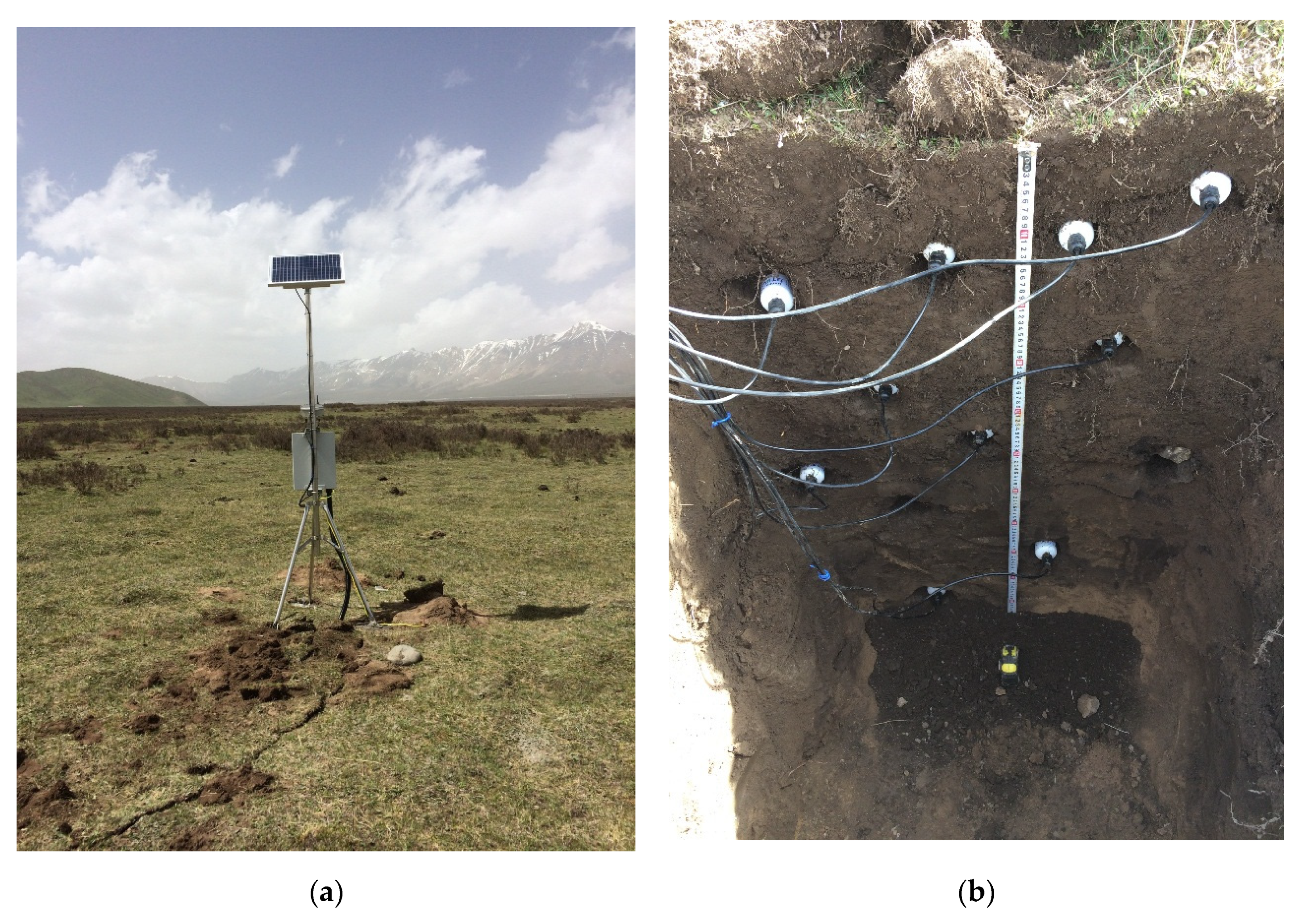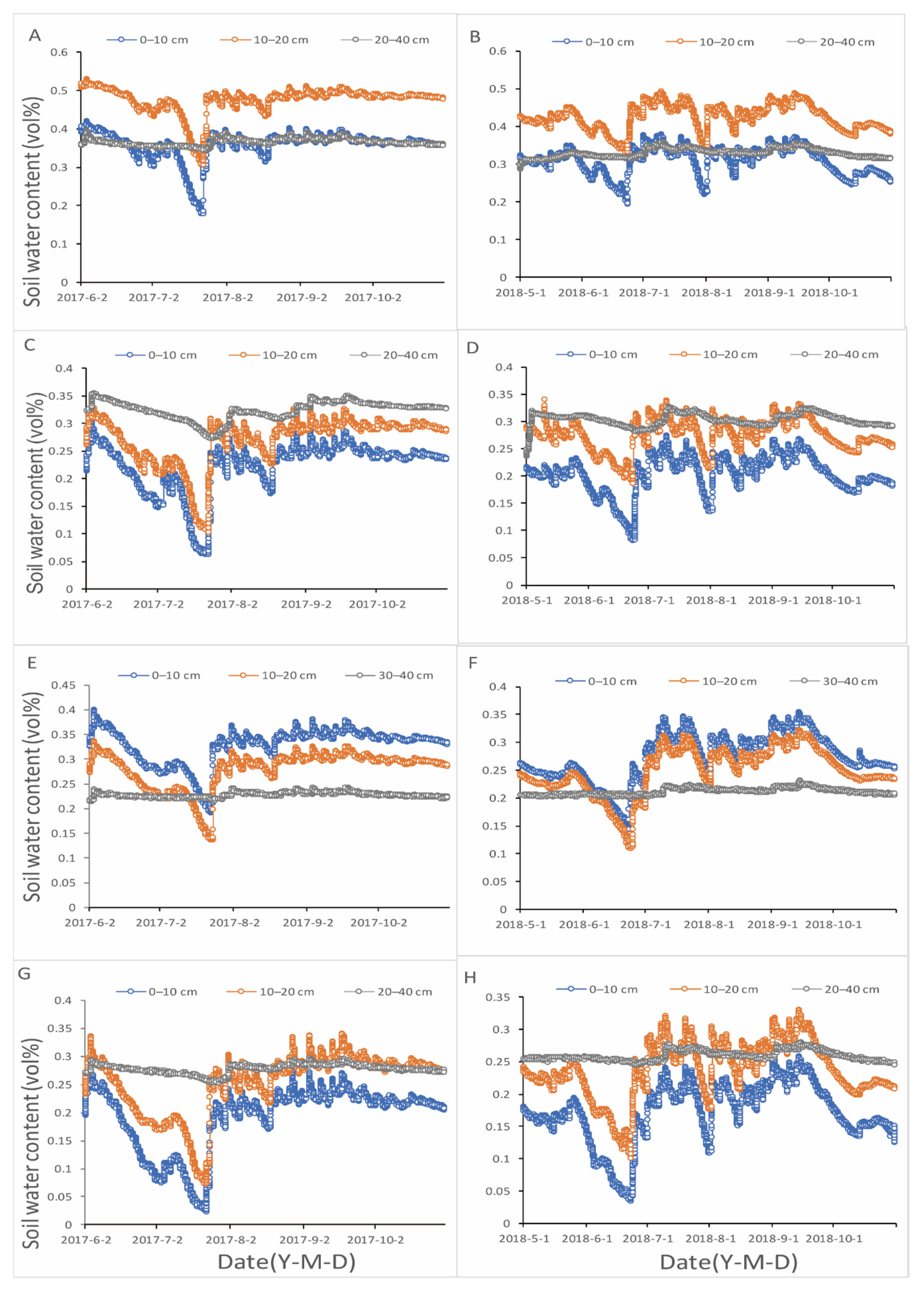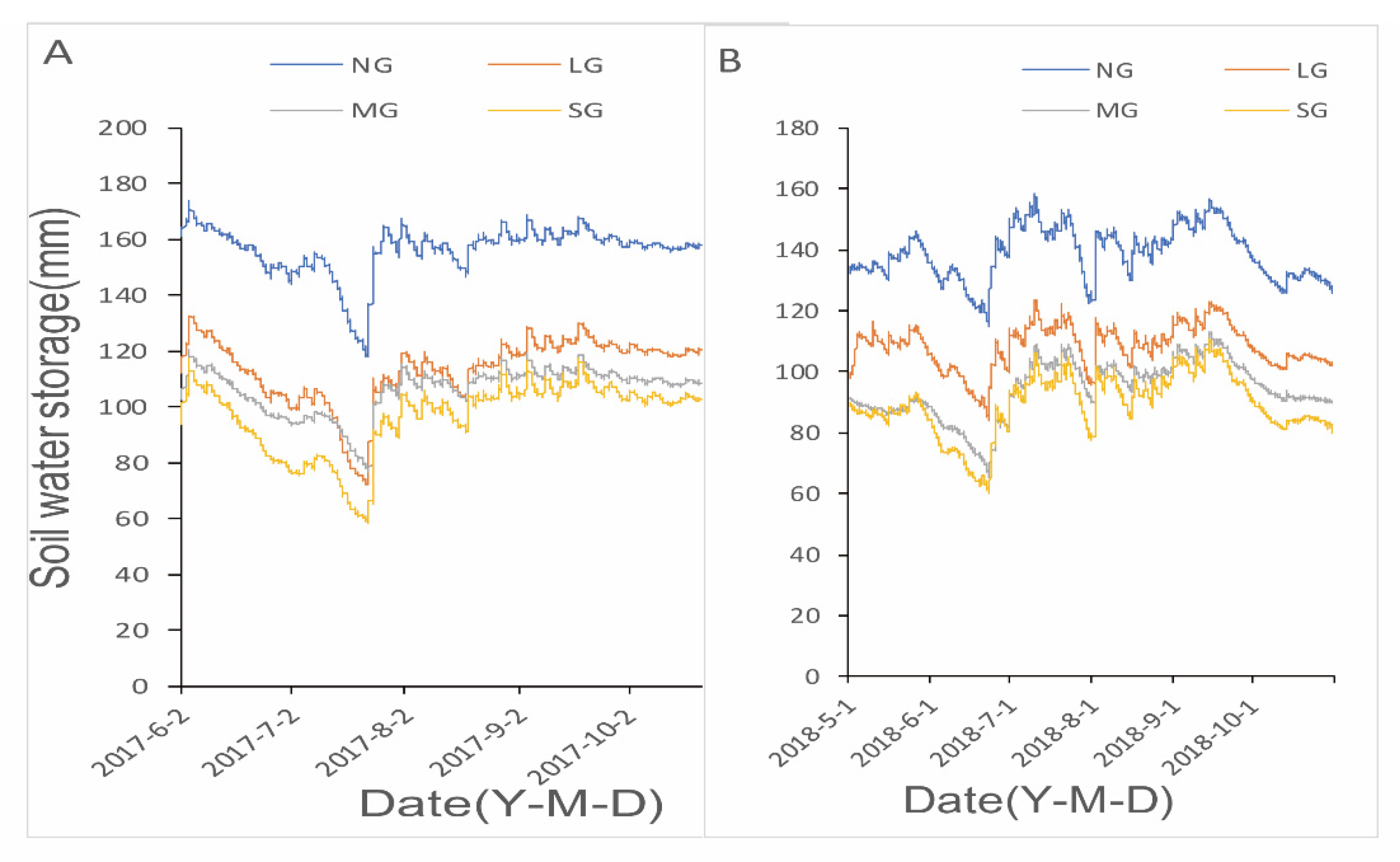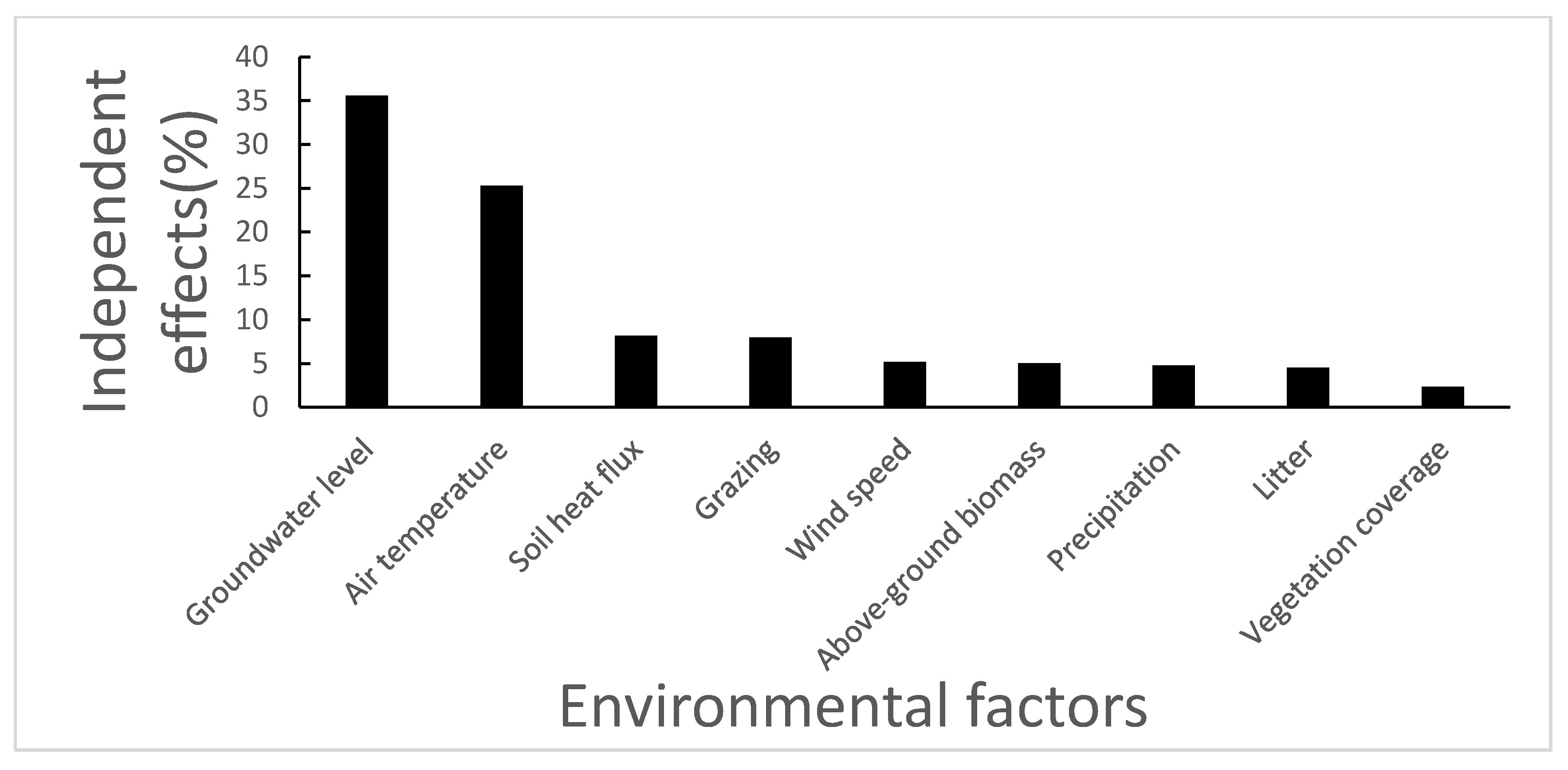Light Grazing Significantly Reduces Soil Water Storage in Alpine Grasslands on the Qinghai-Tibet Plateau
Abstract
1. Introduction
2. Materials and Methods
2.1. Site Description and Experimental Design
2.2. Data Collection
2.3. Statistical Analysis
3. Results
3.1. Soil Water Content in Four Grassland Degradation Classes
3.2. Soil Water Storage in the Four Plots with Varying Degrees of Degradation
3.3. Factors Influencing Water Storage in Alpine Grasslands
4. Discussion
4.1. Factors Influencing Grassland Water Storage
4.2. Grazing Significantly Reduced Soil Water Storage
5. Conclusions
Author Contributions
Funding
Conflicts of Interest
References
- Wang, G.; Liu, G.; Li, C. Effects of changes in alpine grassland vegetation cover on hillslope hydrological processes in a permafrost watershed. J. Hydrol. 2012, 444, 22–33. [Google Scholar] [CrossRef]
- Dong, Q.-M.; Zhao, X.-Q.; Wu, G.-L.; Shi, J.-J.; Ren, G.-H. A review of formation mechanism and restoration measures of “black-soil-type” degraded grassland in the Qinghai-Tibetan Plateau. Environ. Earth Sci. 2013, 70, 2359–2370. [Google Scholar] [CrossRef]
- Ren, G.; Shang, Z.; Long, R.; Hou, Y.; Deng, B. The relationship of vegetation and soil differentiation during the formation of black-soil-type degraded meadows in the headwater of the Qinghai-Tibetan Plateau, China. Environ. Earth Sci. 2013, 69, 235–245. [Google Scholar] [CrossRef]
- Gomez-Plaza, A.; Martinez-Mena, M.; Albaladejo, J.; Castillo, V.M. Factors regulating spatial distribution of soil water content in small semiarid catchments. J. Hydrol. 2001, 253, 211–226. [Google Scholar] [CrossRef]
- Zhao, Z.Z.; Zhao, K.; Xu, J.B.; Xiao, Z.F.; Cui, J.F.; Hong, Z. Spatial-temporal Changes of Surface Albedo and Its relationship with Climate Factors in the Source of Three rivers region. Arid Zone Res. 2014, 31, 1031–1038. [Google Scholar]
- Walker, D.A.; Jia, G.J.; Epstein, H.E.; Raynolds, M.K.; Chapin, F.S.; Copass, C.; Hinzman, L.D.; Knudson, J.A.; Maier, H.A.; Michaelson, G.J.; et al. Vegetation-soil-thaw-depth relationships along a Low-Arctic bioclimate gradient, Alaska: Synthesis of information from the ATLAS studies. Permafr. Periglac. Process. 2003, 14, 103–123. [Google Scholar] [CrossRef]
- Eshtawi, T.; Evers, M.; Tischbein, B.; Diekkrueger, B. Integrated hydrologic modeling as a key for sustainable urban water resources planning. Water Res. 2016, 101, 411–428. [Google Scholar] [CrossRef]
- Dec, D.; Doerner, J.; Balocchi, O.; Lopez, I. Temporal dynamics of hydraulic and mechanical properties of an Andosol under grazing. Soil. Till. Res. 2012, 125, 44–51. [Google Scholar] [CrossRef]
- Pan, T.; Hou, S.; Wu, S.; Liu, Y.; Liu, Y.; Zou, X.; Herzberger, A.; Liu, J. Variation of soil hydraulic properties with alpine grassland degradation in the eastern Tibetan Plateau. Hydrol. Earth Syst. Sci. 2017, 21, 2249–2261. [Google Scholar] [CrossRef]
- Li, J.; Zhang, F.; Lin, L.; Li, H.; Du, Y.; Li, Y.; Cao, G. Response of the plant community and soil water status to alpine Kobresia meadow degradation gradients on the Qinghai-Tibetan Plateau, China. Ecol. Res. 2015, 30, 589–596. [Google Scholar] [CrossRef]
- Su, L.; Yang, Y.; Li, X.; Wang, D.; Liu, Y.; Liu, Y.; Yang, Z.; Li, M. Increasing plant diversity and forb ratio during the revegetation processes of trampled areas and trails enhances soil infiltration. Land Degrad. Dev. 2018, 29, 4025–4034. [Google Scholar] [CrossRef]
- Jiang, C.; Li, D.; Wang, D.; Zhang, L. Quantification and assessment of changes in ecosystem service in the Three-River Headwaters Region, China as a result of climate variability and land cover change. Ecol. Indic. 2016, 66, 199–211. [Google Scholar] [CrossRef]
- FAO. FAO World Reference Base for Soil Resources 2014: International Soil Classification System for Naming Soils and Creating Legends for Soil Maps; FAO: Roma, Italy, 2015. [Google Scholar]
- Whitford, W.G.; Soyza, A.G.D.; Zee, J.W.V.; Herrick, J.E.; Havstad, K.M. Vegetation, Soil, and Animal Indicators of Rangeland Health. Environ. Monit. Assess. 1998, 51, 179–200. [Google Scholar] [CrossRef]
- Du, Y.; Zhou, G.; Guo, X.; Cao, G. Spatial distribution of grassland soil organic carbon and potential carbon storage on the Qinghai Plateau. Grassl. Sci. 2019, 65, 141–146. [Google Scholar] [CrossRef]
- Martínez-Rincón, R.O.; Ortega-García, S.; VacaRodríguez, J.G. Comparative performance of generalized additive models and boosted regression trees for statistical modeling of incidental catch of wahoo (Acanthocybium solandri) in the Mexican tuna purse-seine fishery. Ecol. Model. 2012, 233, 20–25. [Google Scholar] [CrossRef]
- Elith, J.; Leathwick, J.R.; Hastie, T. A working guide to boosted regression trees. J. Anim. Ecol. 2008, 77, 802–813. [Google Scholar] [CrossRef]
- Dai, L.; Guo, X.; Du, Y.; Zhang, F.; Ke, X.; Cao, Y.; Li, Y.; Li, Q.; Lin, L.; Cao, G. The Response of Shallow Groundwater Levels to Soil Freeze-Thaw Process on the Qinghai-Tibet Plateau. Groundwater 2019, 57, 602–611. [Google Scholar] [CrossRef]
- Zvirzdin, D.L.; Roundy, B.A.; Barney, N.S.; Petersen, S.L.; Anderson, V.J.; Madsen, M.D. Postfire soil water repellency in pinon-juniper woodlands: Extent, severity, and thickness relative to ecological site characteristics and climate. Ecol. Evol. 2017, 7, 4630–4639. [Google Scholar] [CrossRef]
- Wall, A.; Heiskanen, J. Water-retention characteristics and related physical properties of soil on afforested agricultural land in Finland. Forest Ecol. Manag. 2003, 186, 21–32. [Google Scholar] [CrossRef]
- Taylor, R.G.; Scanlon, B.; Döll, P.; Rodell, M.; Treidel, H. Ground water and climate change. Nat. Clim. Change 2013, 3, 322–329. [Google Scholar] [CrossRef]
- Bongaarts, J. Intergovernmental Panel on Climate Change Special Report on Global Warming of 1.5 °C Switzerland: IPCC, 2018. Popul. Devel. Rev. 2019, 45, 251–252. [Google Scholar] [CrossRef]
- Sun, G.; Li, Y.; Liu, X.; Cui, N.; Gao, Y.; Yang, Q. Effect of Moistube Fertigation on Infiltration and Distribution of Water-Fertilizer in Mixing Waste Biomass Soil. Sustainability 2019, 11, 6757. [Google Scholar] [CrossRef]
- Lin, L.; Li, Y.K.; Xu, X.L. Predicting parameters of degradation succession processes of Tibetan Kobresia grasslands. Solid Earth 2015, 6, 1237–1246. [Google Scholar] [CrossRef]
- Colman, C.B.; Oliveira, P.T.S.; Almagro, A.; Soares-Filho, B.S.; Rodrigues, D.B.B. Effects of Climate and Land-Cover Changes on Soil Erosion in Brazilian Pantanal. Sustainability 2019, 11, 7053. [Google Scholar] [CrossRef]
- Dai, L.; Guo, X.; Zhang, F.; Du, Y.; Ke, X.; Li, Y.; Cao, G. Seasonal dynamics and controls of deep soil water infiltration in the seasonally-frozen region of the Qinghai-Tibet plateau. J. Hydrol. 2019, 571, 740–748. [Google Scholar] [CrossRef]
- Leemhuis, C.; Thonfeld, F.; Näschen, K.; Steinbach, S.; Muro, J.; Strauch, A.; López, A.; Daconto, G.; Games, I.; Diekkrüger, B. Sustainability in the Food-Water-Ecosystem Nexus: The Role of Land Use and Land Cover Change for Water Resources and Ecosystems in the Kilombero Wetland, Tanzania. Sustainability 2017, 9, 1513. [Google Scholar] [CrossRef]





| Degradation Classification * | No-Degradation Grassland (NG) | Lightly Degraded Grassland (LG) | Moderately Degraded Grassland (MG) | Severely Degraded Grassland (SG) |
|---|---|---|---|---|
| Location | 101°18.798′ E 37°36.666′ N | 101°2.698′ E 37°52.189′ N | 101°10.620′ E 37°40.054′ N | 101°18.237′ E 37°36.676′ N |
| Grazing management *** | 3.5 sheep/hm2 | 8.5 sheep/hm2 | 11.5 sheep/hm2 | 20 sheep/hm2 |
| Exposed soil coverage (%) | 1 ± 1.0a | 8.4 ± 2.6 | 34.0 ± 2.5 | 21.8 ± 5.9 |
| Palatable species absolute coverage (%) | 183.6 ± 42.48 | 42.4 ± 4.88 | 41.6 ± 7.24 | 4.4 ± 2.2 |
| Inedible species absolute coverage (%) | 132.0 ± 24.66 | 56.4 ± 10.84 | 63.3 ± 8.19 | 95.7 ± 2.19 |
| Inedible species aboveground biomass (g/m2) | 126.8 ± 33.28 | 23.2 ± 0.6 | 101.2 ± 18.04 | 182.8 ± 41.24 |
| Soil compactness ** (Kg) | 24.1 ± 3.2 | 27.6 ± 2.2 | 28.1 ± 2.5 | 27.1 ± 3.7 |
| Soil organic matter ** (g/kg) | 244.6 ± 24.7 | 273.8 ± 33.1 | 244.6 ± 22.9 | 180.87707 ± 27.2 |
| Root biomass ** (g/m3) | 4570.3 ± 129.3 | 4329.2 ± 339.6 | 4118.1 ± 496.7 | 4007.9 ± 773.2 |
| Soil total nitrogen ** (g/kg) | 11.9 ± 1.2 | 11.8 ± 1.9 | 10.1 ± 3.6 | 8.1 ± 3.5 |
| Soil bulk density ** (g/cm3) | 0.68 ± 0.13 | 0.72 ± 0.09 | 0.78 ± 0.13 | 0.72 ± 0.16 |
| Dominant species composition and plant community description | Two-layer canopy Upper canopy: Stipa aliena, Helictotrichon tibeticum, Elymus nutans; Lower canopy: Kobresia humilis, Scirpus distigmaticus, Poa crymophila, Dracocephalum heterophyllum Benth | One-layer canopy Stipa aliena, Poa crymophila, Kobresia humilis, toxic species: Oxytropis kansuensis, Leontopodium hastioides, Morina chinensis | Shorter vegetation canopy: Kobresia pygmaea, Saussurea superba, Gentiana straminea, Oxytropis kansuensis, Leontopodium hastioides | Elsholtzia calycocarpa, Ajania tenuifolia, Polygonum sibiricum, Ligularia virgaurea, Potentilla anserina |
| Degradation Classification | Water Content (vol%) 0–10 cm | Water Content (vol%) 10–20 cm | Water Content (vol%) 20–40 cm |
|---|---|---|---|
| NG | 33.1 ± 4.4 ** | 44.6 ± 4.3 ** | 34.5 ± 2.1 ** |
| LG | 21.2 ± 4.2 ** | 27.2 ± 3.6 ** | 31.2 ± 1.7 ** |
| MG | 29.7 ± 4.8 ** | 26.2 ± 4.3 ** | 21.8 ± 1.0** |
| SG | 18.0 ± 5.3 ** | 24.3 ± 4.9 ** | 26.7 ± 1.2** |
© 2020 by the authors. Licensee MDPI, Basel, Switzerland. This article is an open access article distributed under the terms and conditions of the Creative Commons Attribution (CC BY) license (http://creativecommons.org/licenses/by/4.0/).
Share and Cite
Guo, X.; Dai, L.; Li, Q.; Qian, D.; Cao, G.; Zhou, H.; Du, Y. Light Grazing Significantly Reduces Soil Water Storage in Alpine Grasslands on the Qinghai-Tibet Plateau. Sustainability 2020, 12, 2523. https://doi.org/10.3390/su12062523
Guo X, Dai L, Li Q, Qian D, Cao G, Zhou H, Du Y. Light Grazing Significantly Reduces Soil Water Storage in Alpine Grasslands on the Qinghai-Tibet Plateau. Sustainability. 2020; 12(6):2523. https://doi.org/10.3390/su12062523
Chicago/Turabian StyleGuo, Xiaowei, Licong Dai, Qian Li, Dawen Qian, Guangmin Cao, Huakun Zhou, and Yangong Du. 2020. "Light Grazing Significantly Reduces Soil Water Storage in Alpine Grasslands on the Qinghai-Tibet Plateau" Sustainability 12, no. 6: 2523. https://doi.org/10.3390/su12062523
APA StyleGuo, X., Dai, L., Li, Q., Qian, D., Cao, G., Zhou, H., & Du, Y. (2020). Light Grazing Significantly Reduces Soil Water Storage in Alpine Grasslands on the Qinghai-Tibet Plateau. Sustainability, 12(6), 2523. https://doi.org/10.3390/su12062523







